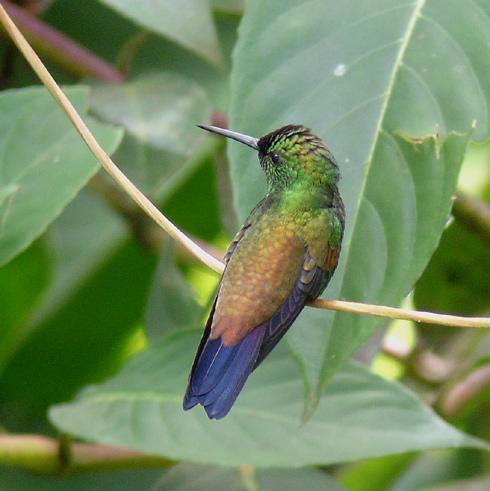| Line 4: | Line 4: | ||
==Identification== | ==Identification== | ||
| − | 9cm. Upperside is green with variable amounts of copper, strongest on the rump, but sometimes | + | 9cm. Upperside is green with variable amounts of copper, strongest on the rump, but sometimes covering all the way to the crown. Wings and tail has a purple-blue sheen; tail is slightly forked. Underside is generally green, blending in to either coppery-cinnamon-rufous or bluish black undertail coverts (variation is geopgraphic and correlates with different subspecies). Mandible can have some flesh colour, but tip is always black. |
==Distribution== | ==Distribution== | ||
Revision as of 18:23, 6 March 2009
- Amazilia tobaci
Saucerottia tobaci
Identification
9cm. Upperside is green with variable amounts of copper, strongest on the rump, but sometimes covering all the way to the crown. Wings and tail has a purple-blue sheen; tail is slightly forked. Underside is generally green, blending in to either coppery-cinnamon-rufous or bluish black undertail coverts (variation is geopgraphic and correlates with different subspecies). Mandible can have some flesh colour, but tip is always black.
Distribution
Trinidad, Tobago and Venezuela.
Taxonomy
The nominate subspecies is found in Tobago while erythronotos inhabits Trinidad. The remaining five subspecies are found in various parts of Venezuela.
Habitat
Rain and cloud forests, second growth, etc. but also gardens and savannas with scattered trees up to 1600 to 1800 metres above sea level.
Behaviour
The diet includes mainly nectar and some insects.
It builds a very small cup shaped nest which is placed on a low branch; the eggs are incubated for 16-17 days, and the young fledge 19-23 days later. There can be 3 broods in a season.
Vocalisation
Call: chip Song: tyee-tyee-tyoo.
References
Wikipedia
External Links
The first of the following links will search for the currently accepted scientific name, the second one for the older one.




